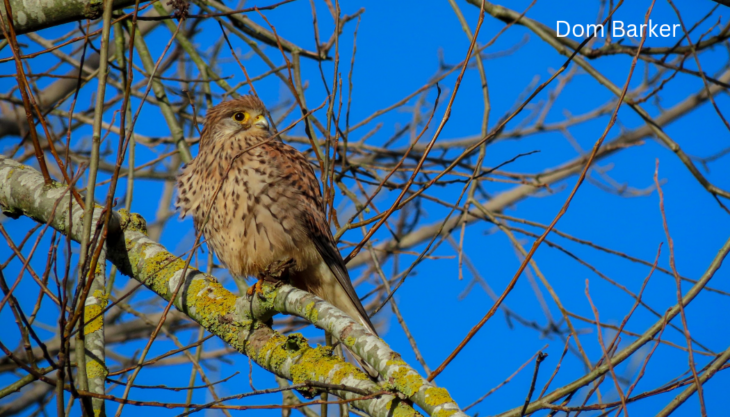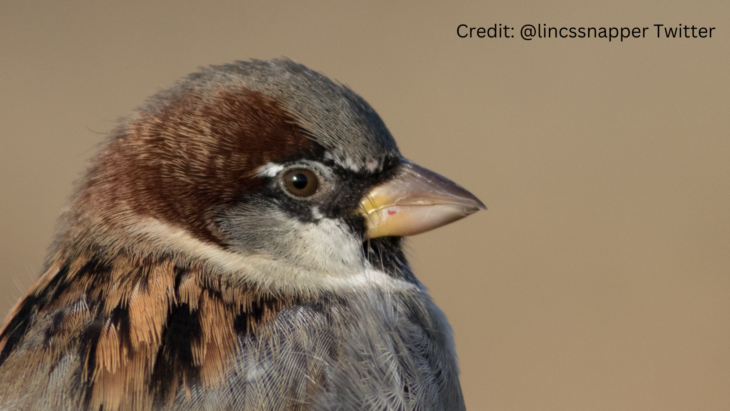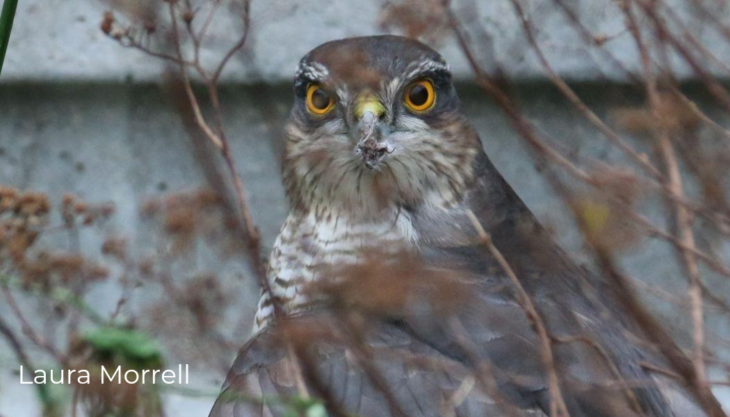Written by Harry Munt, Save the House Sparrow – NBN Trust member
“You need to get a grip Harry, it’s literally a bird…”. That’s the sound of my friend: a wild Matthew in his natural habitat of the concrete jungles of Milton Keynes. And he’s unimpressed.
We’re at a music concert, two among 30,000+ people jumping in unison. The stadium’s throbbing heartbeat. But I’d clocked another animal in its natural habitat. A pair of Peregrine Falcons.
Powerful charcoal arrows as rugged as the rocky escarpments they haunt, they barrelled overhead to-and-fro a purpose-built platform, teetering above the stage. Sometimes they’d temporarily vanish, climbing the thermals high out of the stadium’s gaping top, only to crash Earthwards at breakneck speed, tearing into the Feral Pigeons skittering below.
It was intriguing though… The fastest bird on Earth, teetering over the jaws of extinction mere decades ago, victimized by egg thieves and hunting,1 and often described as an elusive wanderer of open country2. Yet here was an apparently flourishing pair, casually nesting in a stadium blaring music so loud my hearing was off for days.
It made me think.
In wildlife watching, are we a little narrow-minded? Failing to see the bigger picture? Crafting “rules”, for our birdlife especially, in an attempt to translate what nature does in a way we can digest.

Studying for a diploma in Land and Wildlife, it was rigorously drilled into me that Woodlands equalled Flycatchers, Farmland meant Buntings, Scrubland accommodated Finches, and Grouse haunted Moorland. However, as rewilded landscapes such as Knepp Estate have enlightened us to, we’ve learnt that the birds don’t know this! Pre-human, habitats dynamically ebbed and flowed. Grassland, woodland, scrub, and heath all congealed and merged.3
Another widespread “rule” in Britain is that our lush, green countryside is brilliant for birdlife, whereas our urban areas are comparatively barren deserts.
However, this simply isn’t true. Moreover, it’s a reflection of the mechanics behind hobbies like birdwatching. Typically, if you live in quiet, rural area away from the hassle of a city, it’s often a given you’ll engage with your natural surroundings. Recording, painting, managing, and sharing your surrounding birdlife. Alternately, in the pacey melee of lights and sounds of a cityscape, it’s far harder to notice and find solace in birds.
But we should notice, as there’s equally, if not more to see.

Take your average cityscape. View it from a bird’s-eye-view. You’re a Red Kite, wheeling amidst the thermals. You don’t know the “rules”. You’d see open, sunlit grasslands, scattered with Sparrows, Dunnocks and Green Woodpeckers – our parks. Groves of wood and scrubland flitting with bands of Tits and Finches – our gardens. Expansive, dynamic landscapes a-throng with corvids, Wagtails and Black Redstarts – our brownfield sites. Occasionally, a giant cliff (our office blocks) or ancient tree sails by. Potential vantage points to survey from, maybe even nest. However, the bulk of the landscape is consumed by gigantic trees, stuffed with congregations of Sparrows, Starlings and bats, which are chaperoned in Summer by nesting Martins and Swifts – our houses.
Indeed, natural selection is tailoring certain birds to exploit our concrete jungles. House Sparrow and Black Redstart are now categorized as urban birds by the RSPB,4 with House Sparrows rarely nesting over 100m from people5 and Black Redstarts haunting industrial parks, as proxies for cliff habitats.6 Pioneering Waders like Oystercatchers have begun nesting on gravelled rooftops in favour of shingle beaches.7 Raptors like Kites and Sparrowhawks are conquering the open skies.8 In Reading, a city of 160,000+ people,9 1 in 20 gardens are frequented by Red Kites.10 Kestrels have switched prey items in city centres where small mammals are scarce.11 Even birds as disassociated with human habitation as Hobbies have been tentatively exploring. In 1973, Central London was devoid of them. In 1990, 3 pairs bred, with Bedfordshire expanding from 8-30, Nottinghamshire 2–6 and Leicester 5–20 pairs in the same period, utilizing vacant Corvid nests as substitutes for their classic nest sites.12
By actively taking an interest in our curious urban birdlife, not only would we unintentionally conserve it – raising its profile as rural areas have done with their birdlife for centuries, but it’d attract a wealth of new eyes to birdwatching.

Firstly, urban communities are often more diverse than their rural counterparts. 82.9% of the UK’s population live in urban climates, and while the commonest age brackets in rural Britain are 50-54 and 55-59, those in urban ones are 25-29 and 30-34.13 Ironically, the brackets absent from birdwatching are those younger ones, one study finding 10-30y/o as the prime age group most distant from nature.14
Further interest into urban areas would massively diversify the backgrounds of our fellow enthusiasts too.
It’s reported that ‘Environment professionals’ is the second least diverse profession in the UK15, with birdwatching (despite markedly “improving” by some) often dubbed as equally un-inclusive, often excluding non-white ethnic minority peoples.16 Coincidentally, Britain’s “best” cities/urban areas today are cultural hotpots, welling with diversity and culture.17 Meanwhile, many landowners and rural communities are generational-passing down land and ownership through singular bloodlines, and having far lower immigration rates.
In other studies, it’s curiously been found people of higher socio-economic classes visit green spaces more frequently too (77% of people) as opposed to those of lower classes (65%).17 And, with rural landscapes having overall far less poverty (Cheshire, North Yorkshire and parts of Scotland holding the crown of “highest average incomes”18) low socio-economic peoples in dense, inner-city areas who’re currently missing out would be yet another under-represented group that’d be welcomed into birdwatching come an emphasis on urban birdlife.
We need a changed mindset. To forget the rules, like the pair of Peregrines in the stadium. And below are some tips/ways in which we can each have an individual impact and open our eyes to our untapped urban birdlife.
- Forget the rules. Like the birds – stop seeing cities as deserts, and instead a medley of habitats. Put yourself in a bird’s shoes/feathers. A garden = woodland edge. A park, a meadow. Houses, ancient trees.
- Take your passion everywhere. Birdwatching is wonderful in that you can take it wherever you go. Bring your binoculars on the train/bus commute. Go on a nocturnal walk round the block to listen out for migrants flying overhead. And if you have a garden make the most of it.
- Urban species. There’s often an emphasis on the big, the bright and the flashy species in the UK. Think White Stork, Spoonbills, and Hen Harriers. However, while these are fantastical species, and in desperate need of conservation, we must remember our urban neighbours also need attention. Take our commonest urban bird, the House Sparrow. Since 1966, half of all the individual birds lost since 1966 in the UK are House Sparrows alone. That’s nearly one Sparrow a minute. For half a decade.
- Get up early. If you’re a city-dweller, between the hours of 8am – 8pm, people will be everywhere. Flooding your green spaces; wildlife taking cover. So, be sure to exploit the off-peak times. I make a habit of getting up at 6am minimum every morning, giving me a solid couple of hours to spend on my patch before it’s stifled with people. The birds are far more active early and late too.
- Be open. The longer wildlife-watching is deemed as a rural pastime, typically for old generations, the less likely it is to grow. We need young, fresh, and multicultural voices. And with things on the wider conservation agenda such as “prevent the 6th mass extinction of the world’s birdlife” it’d be handy to have as many people on board as possible. So, whatever you do, don’t shy away from your hobby. Don’t be afraid to bring it up in conversation. Wear your binoculars with pride. The more birdwatchers are seen and normalized, especially in under-represented groups, the more public perception will change, and people will get onboard and involved.
Thank-you very much for reading, I hope you’ve enjoyed.
References:
- Peregrine Falcon Population Numbers and Trends – The RSPB. (n.d.). The RSPB. https://www.rspb.org.uk/birds-and-wildlife/wildlife-guides/bird-a-z/peregrine/population-numbers-and-trends/
- Gregory, R., & Holden, P. (2021). RSPB Handbook of British Birds: Fifth Edition. Bloomsbury Publishing Plc. (P.g., 197)
- I, Isabella. (2018). Wilding: The return of nature to a British farm.
- Gregory, R., & Holden, P. (2021). RSPB Handbook of British Birds: Fifth Edition. Bloomsbury Publishing Plc. (P.g., 15)
- A, J, Beer. (2019). RSPB Spotlight: Sparrows. (pg. 72).
- Callahan, D. (2020, October 16). Focus on: Black Redstart. BirdGuides. https://www.birdguides.com/articles/species-profiles/focus-on-black-redstart/
- Appleton, G. (2016, June 13). Oystercatchers: from shingle beach to roof-top. wadertales. https://wadertales.wordpress.com/2016/06/13/oystercatchers-from-shingle-beach-to-roof-top/
- A, J, Beer. (2019). RSPB Spotlight: Sparrows. (pg. 94).
- Profile of Reading. (2011). https://www.reading.gov.uk. https://www.reading.gov.uk/about-reading/profile-of-reading/
- Slevin, J. (2017, February 13). Red kites “commute” into Reading for food handouts. BerkshireLive. https://www.getreading.co.uk/news/local-news/red-kites-commute-reading-food-8981827
- Kestrel Count | London Wildlife Trust. (2021). Retrieved 4 October 2021, from https://www.wildlondon.org.uk/kestrel-count
- British Trust for Ornithology. (2009). Population changes of breeding Hobbies [Ebook] (1st ed., p. 134). Retrieved from https://www.tandfonline.com/doi/pdf/10.1080/00063659409477209
- (2021, October 28). Statistical Digest of Rural England Population. assets.publishing.service.gov.uk. https://assets.publishing.service.gov.uk/government/uploads/system/uploads/attachment_data/file/1028819/Rural_population__Oct_2021.pdf
- Simmonds, G. (2019, June). Finding Nature | Nature Connectedness Research Blog by Prof. Miles Richardson. https://findingnatureblog.files.wordpress.com/2019/06/blogchart2.jpg
- Norrie, R (2017, March) The Two Sides of Diversity: Which are the most ethnically diverse
occupations? – https://policyexchange.org.uk/wp-content/uploads/2017/03/The-two-sides-of-diversity-2.pdf - Craig, M.-R. (2019, April 11). How do we change a whole sector?https://cieem.net/colonialism-in-conservation/
- Parker, K., Horowitz, J. M., Brown, A., Fry, R., Cohn, D., & Igilenik, R. (2018, May 22). What Unites and Divides Urban, Suburban and Rural Communities. Pew Research Center’s Social & Demographic Trends Project. https://www.pewresearch.org/social-trends/2018/05/22/what-unites-and-divides-urban-suburban-and-rural-communities/
- What are the regional differences in income and productivity?(2021, May 17). Home – Office for National Statistics. https://www.ons.gov.uk/visualisations/dvc1370/
